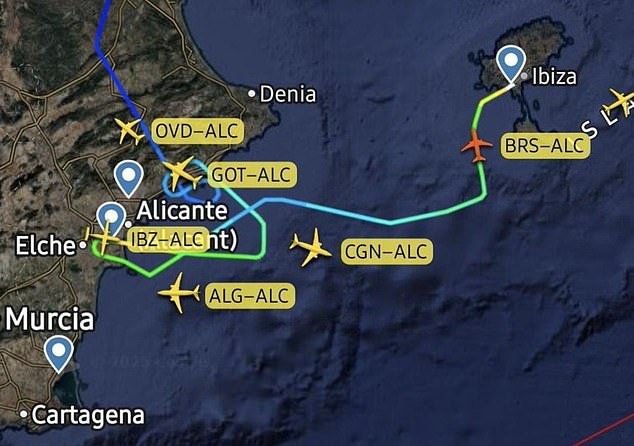Sunny Costa Blanca has been struck by Mega Storm Alice, leaving tourists stranded as several flights are diverted and cancelled.
The holiday hot-spot, which is popular among sun-seeking Brits, was placed on high alert as Spain braces for heavy rains and strong winds, with officials warning of ‘extraordinary danger’.
Seven flights heading for Alicante-Elche airport were diverted on Friday, the travel hub’s operator Aena said.
A graphic shared by flight tracking website Flighradar24 showed a number of planes circling around Alicante airport as a result of the travel disruptions.
The operator also said 12 flights were cancelled on Friday due to the weather warning.
As for Valencia and Murcia’s airports, several flights have already suffered serious delays.
Meanwhile, the Foreign Office has issued a warning to Brits planning to travel to Spain, warning of ‘severe’ weather conditions on its eastern coast.
‘Severe weather warnings are in place today in Murcia and Valencia, including the province of Alicante. Disruptions to travel are likely. If you are in the affected areas, follow the advice of the local authorities and monitor local weather updates. If you are planning to travel, check for messaging from your travel provider or airline’, it said in a statement.

Flights heading towards some of Spain ‘s major airports have been diverted as a result of Storm Alice

Tourists heading to Spain’s Mediterranean shores have been urged to monitor local weather updates and follow official guidance

A volunteer is seen cleaning a flooded street
AEMET, Spain’s weather agency, issued a red warning for heavy rains in the resort town of Alicante and said it would come into effect from Friday morning, but the worst of the storm is yet to take hold.
‘Extraordinary danger. Flooding and flash floods may occur. Follow the advice of civil protection,’ the agency wrote on X.
Rainfall totals could exceed 140 millimetres in 12 hours, especially in Valencia, the weather office said.
Other Mediterranean coastal regions are also expected to be affected, including the neighbouring province of Murcia and the Balearic islands, with ‘very heavy and persistent rainfall’ was expected until Monday, AEMET added.
‘Showers may result in local flash flooding in low-lying areas, streams and gullies, so the potential danger level of this situation is high’, the agency added.
The Balearic government said on Thursday it had reinforced emergency services in party island Ibiza after it was placed on an orange alert for rain and storms.
Heavy rainfall began lashing down on eastern Spain on Wednesday evening and is expected to persist throughout the week.
Tourists heading to Spain’s Mediterranean shores have been urged to monitor local weather updates and follow official guidance.
Footage shared on social media shows how heavy rainfall has already been affecting the coastal regions in eastern Spain, with videos showing cars attempting to drive down flooded roads and volunteers clearing water and mud from streets.
Another video shows how a car was trapped in water after heavy rainfall.

AEMET, Spain’s weather agency, on Thursday issued a red alert for heavy rains in holiday hotspot Alicante

AEMET said the red alert would be in effect from 10:00 am (0800 GMT) on Friday in Mediterranean coastal regions of the province of Alicante, as well as in the neighbouring region of Murcia

Graphic shared by AEMET shows the regions of Spain affected by the storm on Friday

Videos shared on social media show flooded roads
The weather forecast has forced authorities in the region of Murcia to evacuate a housing estate and close schools across 13 municipalities on Friday.
President of Murcia Fernando Lopez Miras called for ‘caution’ and warned residents that ‘the worst of the storm is expected [on Friday]’.
No serious incidents have been reported, but emergency services in Murcia had to respond to an elderly person who sustained minor injuries after heavy rain caused a roof to collapse, Spanish newspaper El Pais reports.
During the early hours of Friday morning, emergency services said they carried out several water pumping operations in the Valencian municipality of Alcasser and reported some fallen trees.
Authorities are taking heightened measures as the storm comes nearly a year after widespread flooding in Valencia killed more than 200 people, Spain’s worst natural disaster in decades.
The catastrophe sparked public fury over warning systems and the emergency response.
Residents continue to protest, accusing officials of having failed to provide timely alerts.
Heavy rains lashed the region again last month, forcing the closure of schools and universities, disrupting rail and road travel and causing localised flooding.

A passerby observes a vehicle wrapped in plastic in Catarroja municipality, Valencia, Spain, 09 October 2025 as the region is on high alert due to Storm Alice

Rainfall totals could exceed 140 millimetres (five and a half inches) in 12 hours, especially in Valencia, the weather office said
Because a hotter atmosphere holds more water that evaporates from a rapidly warming Mediterranean Sea, climate change increases the risk and intensity of flooding from extreme rainfall in the region.
Almost 240 people died in the country after torrential rains last October triggered floods that swept through eastern and southeastern Spain.
The most severely hit area was Valencia’s southern suburbs where more than 220 people died.
This article was originally published by a www.dailymail.co.uk . Read the Original article here. .

